
Concept explainers
(a)
Interpretation: The heat of the reaction on each diagram is to be labeled.
Concept introduction:When a reaction occurs, some bond formed and some bonds are broken. Every reaction goes through the intermediate stage. The intermediate is very unstable and therefore have highest energy.The diagram which represents the relative energy of reactant, product, and transition state is termed as energy diagram.
(a)
Answer to Problem 5E
The heat of the reaction

Explanation of Solution
The given energy diagram is shown below:

The heat of a reaction

(b)
Interpretation: The activation energy on each diagram is to be labeled.
Concept introduction: When a reaction occurs, some bond formed and some bonds are broken. Every reaction goes through the intermediate stage. The intermediate is very unstable and therefore have highest energy. The diagram which represents the relative energy of reactant, product, and transition state is termed as energy diagram.
(b)
Answer to Problem 5E
The activation energy
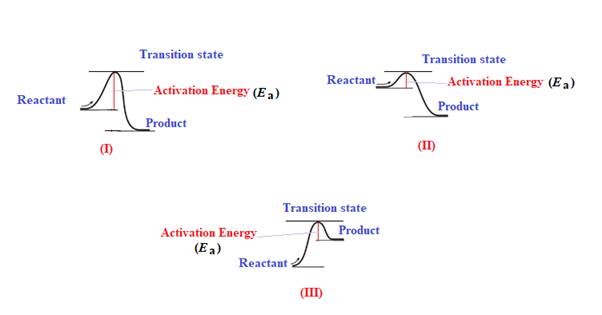
Explanation of Solution
The given energy diagram is shown below:
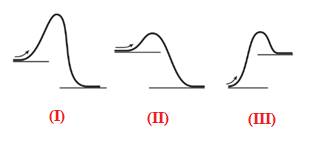
The energy required to reach a reactant to its transition state is termed as activation energy
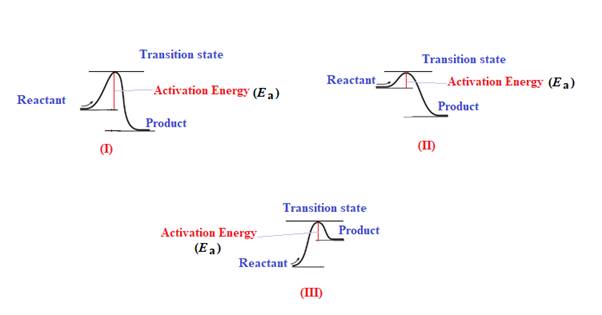
(c)
Interpretation: The diagram which represents the most exothermic reaction is to be predicted.
Concept introduction: When a reaction occurs, some bond formed and some bonds are broken. Every reaction goes through the intermediate stage. The intermediate is very unstable and therefore have highest energy. The diagram which represents the relative energy of reactant, product, and transition state is termed as energy diagram.
(c)
Answer to Problem 5E
The diagram which represents the most exothermic reaction is shown below:
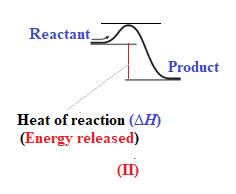
Explanation of Solution
The given energy diagram is shown below:
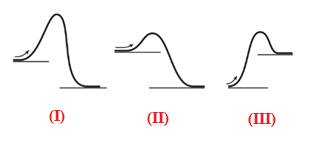
The reaction in which the energy of the product is less than the energy of reactant is termed as exothermic reaction. In an exothermic reaction, energy releases.In diagram (I) and (II), the energy of energy of the product is less than the energy of reactant. Therefore, diagram (I) and (II)represents exothermic reaction as shown below:
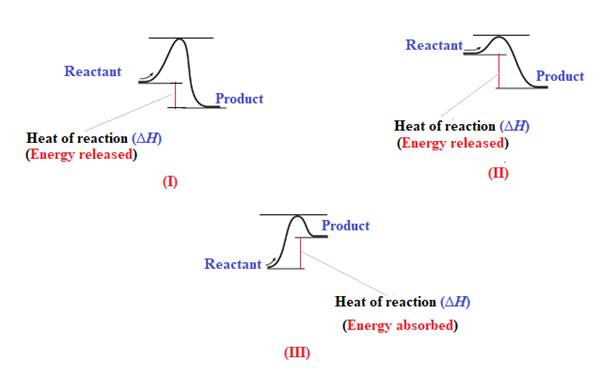
In diagram (II), the difference in the energy is more. Therefore, diagram (II) represents most exothermic reaction as shown below:

(d)
Interpretation: The reaction which requires energy to get started is to be predicted.
Concept introduction: When a reaction occurs, some bond formed and some bonds are broken. Every reaction goes through the intermediate stage. The intermediate is very unstable and therefore have highest energy. The diagram which represents the relative energy of reactant, product, and transition state is termed as energy diagram.
(d)
Answer to Problem 5E
Endothermic reaction requires energy to get started. Diagram (III) represents the endothermic reaction as shown below:
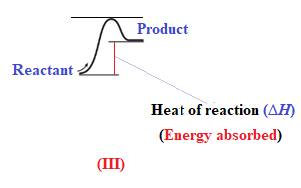
Explanation of Solution
The given energy diagram is shown below:
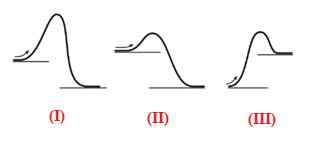
The reaction in which the energy of the product is more than the energy of reactant is termed as endothermic reaction. In an endothermic reaction, energy absorbs. In diagram (III), the energy of energy of the product is more than the energy of reactant. Therefore, diagram (III) represents an endothermic reaction as shown below:

It is known that endothermic reaction requires energy to get started. Therefore, diagram (III) is represents the endothermic reaction as shown below:

Chapter U5 Solutions
Living by Chemistry
Additional Science Textbook Solutions
Introductory Chemistry (5th Edition) (Standalone Book)
Chemistry: The Central Science (14th Edition)
Chemistry: Structure and Properties (2nd Edition)
Chemistry: Matter and Change
Chemistry & Chemical Reactivity
 ChemistryChemistryISBN:9781305957404Author:Steven S. Zumdahl, Susan A. Zumdahl, Donald J. DeCostePublisher:Cengage Learning
ChemistryChemistryISBN:9781305957404Author:Steven S. Zumdahl, Susan A. Zumdahl, Donald J. DeCostePublisher:Cengage Learning ChemistryChemistryISBN:9781259911156Author:Raymond Chang Dr., Jason Overby ProfessorPublisher:McGraw-Hill Education
ChemistryChemistryISBN:9781259911156Author:Raymond Chang Dr., Jason Overby ProfessorPublisher:McGraw-Hill Education Principles of Instrumental AnalysisChemistryISBN:9781305577213Author:Douglas A. Skoog, F. James Holler, Stanley R. CrouchPublisher:Cengage Learning
Principles of Instrumental AnalysisChemistryISBN:9781305577213Author:Douglas A. Skoog, F. James Holler, Stanley R. CrouchPublisher:Cengage Learning Organic ChemistryChemistryISBN:9780078021558Author:Janice Gorzynski Smith Dr.Publisher:McGraw-Hill Education
Organic ChemistryChemistryISBN:9780078021558Author:Janice Gorzynski Smith Dr.Publisher:McGraw-Hill Education Chemistry: Principles and ReactionsChemistryISBN:9781305079373Author:William L. Masterton, Cecile N. HurleyPublisher:Cengage Learning
Chemistry: Principles and ReactionsChemistryISBN:9781305079373Author:William L. Masterton, Cecile N. HurleyPublisher:Cengage Learning Elementary Principles of Chemical Processes, Bind...ChemistryISBN:9781118431221Author:Richard M. Felder, Ronald W. Rousseau, Lisa G. BullardPublisher:WILEY
Elementary Principles of Chemical Processes, Bind...ChemistryISBN:9781118431221Author:Richard M. Felder, Ronald W. Rousseau, Lisa G. BullardPublisher:WILEY





